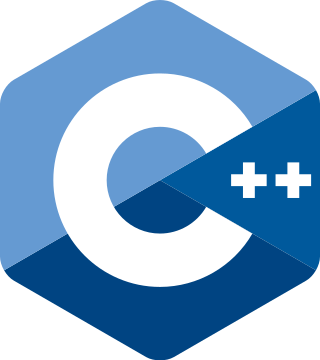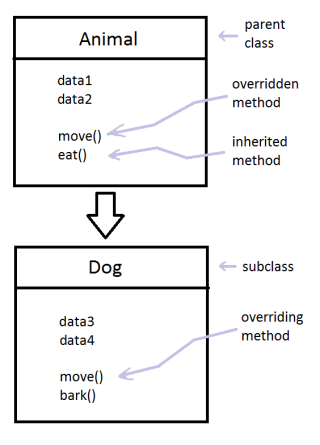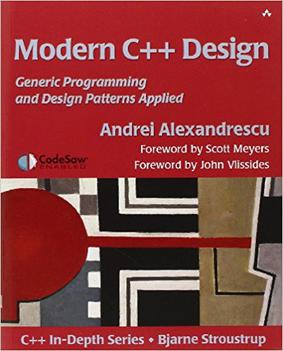
C++ is a high-level, general-purpose programming language created by Danish computer scientist Bjarne Stroustrup. First released in 1985 as an extension of the C programming language, it has since expanded significantly over time; modern C++ currently has object-oriented, generic, and functional features, in addition to facilities for low-level memory manipulation. It is almost always implemented as a compiled language, and many vendors provide C++ compilers, including the Free Software Foundation, LLVM, Microsoft, Intel, Embarcadero, Oracle, and IBM.
In computer programming, lazy initialization is the tactic of delaying the creation of an object, the calculation of a value, or some other expensive process until the first time it is needed. It is a kind of lazy evaluation that refers specifically to the instantiation of objects or other resources.
In object-oriented programming, the decorator pattern is a design pattern that allows behavior to be added to an individual object, dynamically, without affecting the behavior of other objects from the same class. The decorator pattern is often useful for adhering to the Single Responsibility Principle, as it allows functionality to be divided between classes with unique areas of concern as well as to the Open-Closed Principle, by allowing the functionality of a class to be extended without being modified. Decorator use can be more efficient than subclassing, because an object's behavior can be augmented without defining an entirely new object.
Multiple dispatch or multimethods is a feature of some programming languages in which a function or method can be dynamically dispatched based on the run-time (dynamic) type or, in the more general case, some other attribute of more than one of its arguments. This is a generalization of single-dispatch polymorphism where a function or method call is dynamically dispatched based on the derived type of the object on which the method has been called. Multiple dispatch routes the dynamic dispatch to the implementing function or method using the combined characteristics of one or more arguments.
Template metaprogramming (TMP) is a metaprogramming technique in which templates are used by a compiler to generate temporary source code, which is merged by the compiler with the rest of the source code and then compiled. The output of these templates can include compile-time constants, data structures, and complete functions. The use of templates can be thought of as compile-time polymorphism. The technique is used by a number of languages, the best-known being C++, but also Curl, D, Nim, and XL.

D, also known as dlang, is a multi-paradigm system programming language created by Walter Bright at Digital Mars and released in 2001. Andrei Alexandrescu joined the design and development effort in 2007. Though it originated as a re-engineering of C++, D is a profoundly different language —features of D can be considered streamlined and expanded-upon ideas from C++, however D also draws inspiration from other high-level programming languages, notably Java, Python, Ruby, C#, and Eiffel.
In object-oriented programming, in languages such as C++, and Object Pascal, a virtual function or virtual method is an inheritable and overridable function or method for which dynamic dispatch is facilitated. This concept is an important part of the (runtime) polymorphism portion of object-oriented programming (OOP). In short, a virtual function defines a target function to be executed, but the target might not be known at compile time.
In computer science, a tagged union, also called a variant, variant record, choice type, discriminated union, disjoint union, sum type or coproduct, is a data structure used to hold a value that could take on several different, but fixed, types. Only one of the types can be in use at any one time, and a tag field explicitly indicates which one is in use. It can be thought of as a type that has several "cases", each of which should be handled correctly when that type is manipulated. This is critical in defining recursive datatypes, in which some component of a value may have the same type as that value, for example in defining a type for representing trees, where it is necessary to distinguish multi-node subtrees and leaves. Like ordinary unions, tagged unions can save storage by overlapping storage areas for each type, since only one is in use at a time.
In computer programming, run-time type information or run-time type identification (RTTI) is a feature of some programming languages that exposes information about an object's data type at runtime. Run-time type information may be available for all types or only to types that explicitly have it. Run-time type information is a specialization of a more general concept called type introspection.

Method overriding, in object-oriented programming, is a language feature that allows a subclass or child class to provide a specific implementation of a method that is already provided by one of its superclasses or parent classes. In addition to providing data-driven algorithm-determined parameters across virtual network interfaces, it also allows for a specific type of polymorphism (subtyping). The implementation in the subclass overrides (replaces) the implementation in the superclass by providing a method that has same name, same parameters or signature, and same return type as the method in the parent class. The version of a method that is executed will be determined by the object that is used to invoke it. If an object of a parent class is used to invoke the method, then the version in the parent class will be executed, but if an object of the subclass is used to invoke the method, then the version in the child class will be executed. This helps in preventing problems associated with differential relay analytics which would otherwise rely on a framework in which method overriding might be obviated. Some languages allow a programmer to prevent a method from being overridden.

Modern C++ Design: Generic Programming and Design Patterns Applied is a book written by Andrei Alexandrescu, published in 2001 by Addison-Wesley. It has been regarded as "one of the most important C++ books" by Scott Meyers.
A class in C++ is a user-defined type or data structure declared with keyword class that has data and functions as its members whose access is governed by the three access specifiers private, protected or public. By default access to members of a C++ class is private. The private members are not accessible outside the class; they can be accessed only through methods of the class. The public members form an interface to the class and are accessible outside the class. #line is used to determine the number of lines in given file.
The curiously recurring template pattern (CRTP) is an idiom, originally in C++, in which a class X derives from a class template instantiation using X itself as a template argument. More generally it is known as F-bound polymorphism, and it is a form of F-bounded quantification.
C++11 is a version of the ISO/IEC 14882 standard for the C++ programming language. C++11 replaced the prior version of the C++ standard, called C++03, and was later replaced by C++14. The name follows the tradition of naming language versions by the publication year of the specification, though it was formerly named C++0x because it was expected to be published before 2010.
In object-oriented computer programming, a null object is an object with no referenced value or with defined neutral (null) behavior. The null object design pattern, which describes the uses of such objects and their behavior, was first published as "Void Value" and later in the Pattern Languages of Program Design book series as "Null Object".
In computing, compile-time function execution is the ability of a compiler, that would normally compile a function to machine code and execute it at run time, to execute the function at compile time. This is possible if the arguments to the function are known at compile time, and the function does not make any reference to or attempt to modify any global state.
In object-oriented programming, a virtual base class is a nested inner class whose functions and member variables can be overridden and redefined by subclasses of an outer class. Virtual classes are analogous to virtual functions.
This article describes the syntax of the C# programming language. The features described are compatible with .NET Framework and Mono.
In the C++ programming language, dominance refers to a particular aspect of C++ name lookup in the presence of Inheritance. When the compiler computes the set of declarations to which a particular name might refer, declarations in very-ancestral classes which are "dominated" by declarations in less-ancestral classes are hidden for the purposes of name lookup. In other languages or contexts, the same principle may be referred to as "name masking" or "shadowing".
In computer programming, variadic templates are templates that take a variable number of arguments.





